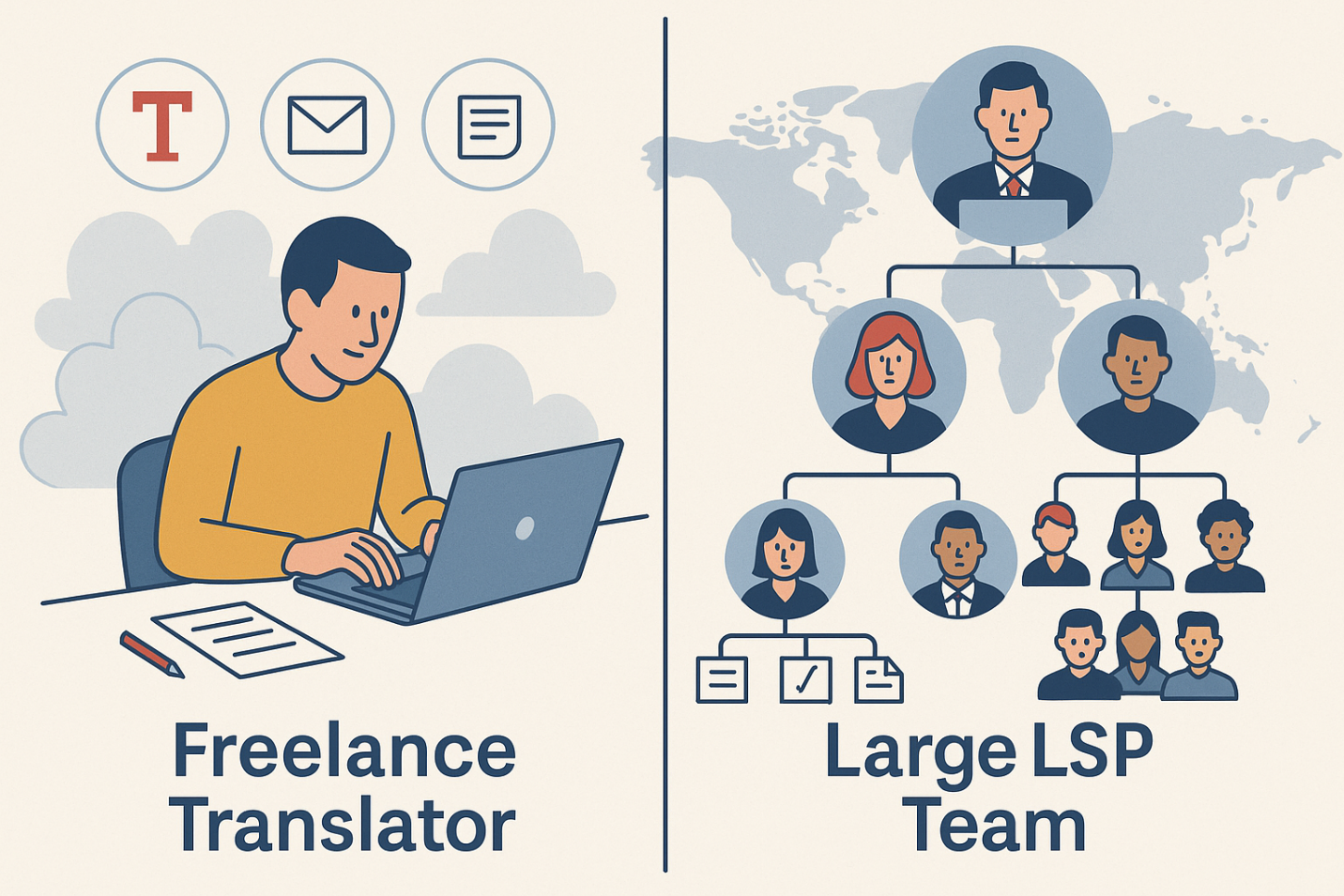
The work of a translation agency project manager can get the adrenaline pumping. It is rare that a project flows smoothly from beginning to end: plenty of good translators on your team, deadlines that mean you don’t have to rush, no unpleasant surprises etc.
No matter what’s happening in your agency, your task is to deliver a good quality translation to the client in a timely manner. In other words, letting down the client is not an option, especially is this is the first project you are doing for them. If you send the translation late or they find mistakes, the client is hardly going to believe you’ve never had these problems before.
In this article we discuss how you can minimize misunderstandings with clients.
Put yourself in the client’s place
Obviously this doesn’t mean you have to look deep within their souls (although sometimes it doesn’t hurt). You need to understand exactly what they want from you. And this is often no trivial task.
If the client isn’t another outsourcing agency or rarely uses translation services, they are unlikely to have a clear idea about how translation companies work. It’s likely their demands and instructions will be extremely brief (”Translate this text”) and they won’t send you any glossaries, style manuals or even comparative materials. You’ll often get an Excel file of sentences taken completely out of context. Quite often, besides the translation, the job will also involve preliminary character recognition and/or subsequent formatting.
You may well be amazed by such “negligence”, but for the clients these are all extraneous details. They just want a translation of the text, and they’re not interested (and if you think about it, nor should they be interested) in how exactly the agency creates it.
The problems come when you can’t guess all the requirements that the client has but doesn’t mention. For example, the text is aimed at children aged 7-10 years, and the translation contains terminology that children won’t understand. Or the client has its own corporate terminology that the translator doesn’t know about, and hence doesn’t use it. Maybe the client just doesn’t like the quality but can’t explain why.
So you have to clarify all the requirements with new clients as soon as possible to minimize the risks. For a start, ask some basic questions, for example about the file format and the target audience for the text. Ascertain whether the client has any particular set of corporate standards that you’ll have to work with. Suggest a strategy for completing the project and find out if that works for the client.
The best thing is to put all of this in writing. A month from now, any verbal agreements you have made will be forgotten. Don’t rely on memory: it’s sure to leave you with false recollections that are guaranteed to differ from the recollections of the client (which will also be false).
Submit a sample translation as early as possible
If it’s a big project and the client is new then it’s best not to wait until the whole translation is done before going all-in. You need to bring out any possible rifts right away. If you have a partial translation whose quality you are confident of, send it straight over to the client and makes sure you get them to send feedback.
Even if it turns out that the client categorically doesn’t like either the translation or you personally, and that they’re planning to end any further collaboration immediately, that blow is going to be less damaging than refusing to pay for a huge project that your team has spent two months working on, with overtime at evenings and weekends. Such negative scenarios very rarely occur. Normally the client will meet you halfway and point out exactly what needs to be corrected.
You sometimes get clients who are very reticent. They accept the translation as it is, and their feedback is limited to the words, “Thank you, file received.” This could mean that they are happy with everything, but it could also indicate that they haven’t even looked at the file and will only open it once the whole project is complete. It is therefore imperative that you confirm with the client whether or not they have any comments.
Ask questions
For any questions that come up in the course of the project, make sure you ask the client and get answers to them. For example, in the source text there is a clear semantic error or the client’s instructions contradict the rules of the language the translation is being performed in. You may choose not to reflect the mistake in the translation or ignore the client’s instructions, given that this would seem to be common sense. But that’s a risk: what if you just don’t know the client’s intentions, and the mistake is deliberate?
If you don’t get an answer to this question, you can use your own discretion but you have to inform the client immediately — again, in writing, to avoid false memories in future. Until the project is completed, and for a period of time afterwards (say, one year) do not delete your correspondence with the client.
Warn them of the consequences in advance
Sometimes clients make demands that have the potential to do damage to them — for example, to put all glossary terms in the nominative case in all instances even in flective languages like Russian. Or to strictly follow a glossary that contains clear mistakes.
As a professional, you know that obeying instructions like this will only harm the quality of the text and damage the client’s reputation. But by refusing to obey them you invite the wrath of the client’s project manager onto yourself. And absurd as it may be, you’ll have to justify and explain what to a native speaker of the language are its obvious rules, cultural traditions and so on. Even then your arguments will by no means always be accepted. But if you simply carry out instructions that are detrimental to the quality of the text, then one fine day the client may ask why you didn’t say anything about this before.
You can resolve that conflict between “the client is always right” and “I want to do what’s best for the client” using a quasi-legal procedure, that shifts responsibility onto the client. It looks something like this: if the client persists in demanding you do something that you believe is contrary to common sense, set out the consequences of that decision to them right away and ask them to take responsibility themselves.
For example: “You are asking us to follow a glossary that contains clear errors. We can do that no problem. But please confirm that you will not make any complaints as to the correctness of the terminology later on.” Forced to consider THEIR OWN responsibility, the client will either take a moment to think about it and change their instructions, or take the responsibility themselves. Either way, you are covered.
Communicate any bad news
Sometimes projects don’t go the way you anticipated: a translator falls ill or has simply overestimated themselves, there have been problems with their internet connection or software, and it’s going to take more people to complete the translation than you had originally planned for. As a result, the time you allocated to do it may not be enough.
In an ideal world, the translation project manager should foresee such situations and come up with a way out in advance. The client doesn’t need to know about all the dramas that go on inside the agency: the translation has to be delivered on time regardless.
But force-majeure does not discriminate. It is perfectly possible to end up with a situation that was impossible to foresee: for example, the only translator of some obscure language on your team gets into an accident right in the middle of the project, and you know it will be impossible to find a replacement any time soon, meaning the project will have to be submitted late. Or a more commonplace situation: the translator has been working on a desktop application, but because the hard drive has crashed they’ve lost all their work from the last three days, and the project is due to be submitted tomorrow.
This news is going to upset the client of course. But if you can’t get round a problem that has arisen in such a way that it does not affect the process of completing the project, tell the client about it right away. At least they will then be forewarned about the difficulties that have arisen in the lead-up to the submission deadline and can’t accuse you of covering up problems Otherwise you end up getting in the way of the client making a decision that works better them — for example, to transfer a part of the project to a different agency or simply to extend the deadline for you, adjusting plans for completing the project.
Don’t get bogged down in the details
In their efforts to attract clients, managers sometimes start talking about CAT tools, quality control systems, standards etc. If the client isn’t familiar with the translation industry, then all these nuances will go completely over their head. They don’t need to know about them.
That kind of information has to be given out carefully and in small doses. Find out if the client needs these details or if they just need a text translated.
Picture the scene: Your car has broken down, you take it to the service center and the mechanic there starts telling you animatedly about pistons, the inner workings of the transmission box and the electrolyte density in the battery. It’s all surplus information to you: you just need the car to drive.
It may seem like this advice contradicts that given above that says “Ask questions”. But they’re not mutually exclusive: you have to find the right balance with every client.
Be polite — always
It is a rare translation project manager that can come to all of the situations described above with a cool head. Clients will never cease to shock, irritate and amaze you — to provoke all different kinds of emotions. But whatever emotions they may be, never lose your composure. Keep a clear head, and be polite no matter the situation.
The chances of reaching a mutual understanding will improve if you just get to know the client a little better. And in most cases it is possible to alleviate any friction that may arise.
Perceived impoliteness sometimes stems from a difference in mindset. For example, the average American and British person will talk to you differently, but that doesn’t mean that one of them has a better or worse attitude towards you.
If you suddenly encounter that rare situation where the person you are speaking with is being genuinely unreasonable, remember: colleagues and managers on the client’s side, their co-workers, will be following your conversations, especially the written ones, and if any complaint should be raised to a legal level, lawyers will be too. And if you aren’t able to create the impression of a judicious, polite individual, the sympathies of those observing your altercation from the outside may well fall on the side of your “unreasonable” counterpart. Sometimes the important thing isn’t beating your opponent so much as beating the crowd.
You can’t avoid problems completely
The methods outlined above can’t rule out all possible misunderstandings with clients. You don’t have to follow every bit of advice to the letter — with every individual client you have to find an approach that works for you. But if you observe these basic rules you will rule out a whole host of problems or at least reduce them to a minimum.

.png)

.png)

